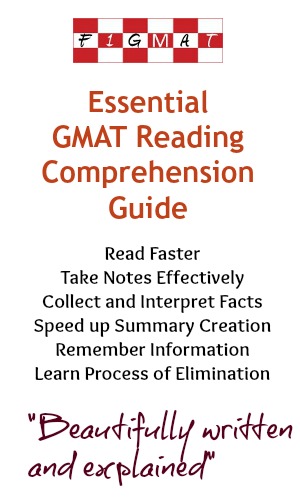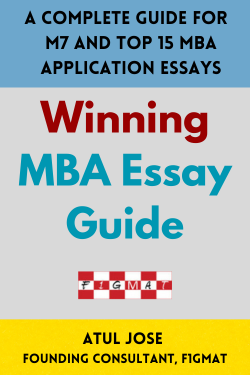In early 1990, Isabel Beck and Margaret McKeown pioneered a new reading comprehension technique - questioning the author. The technique involved critical questioning of the author, and his intentions. By focusing on the thought process and motivation behind the articles, readers were better equipped to recognize biases, and how the author manipulates facts while forming an opinion.
Here are five Steps to question the Author
1) Find the Author’s Knowledge
GMAT reading comprehension questions require looking at the passage as a reference and finding the answers to the questions asked. There is no point in questioning the author’s knowledge except in cases where the question is about the assumptions of the author. Your knowledge about the subject matter would help you understand whether the author is misinterpreting facts to make a point. But in most cases, GMAT Reading Comprehension includes diverse topics ranging from ecological preservation, financial systems and rights of African-Americans. You are not expected to be scholars in these topic areas, and hence beating the author on knowledge is less likely. But it helps to know more than the author to recognize the thoughts he articulates while making a point.
2) Find the Information Link
For example, the Bengal famine of 1943 would be interpreted as a natural famine by the author with biases in favor of the British Empire. But an Indian nationalist would add another information – Bengal Exported the most quantity of grains in 1943, clearly indicating the British Empire’s priority of profit over the welfare of their colony. Spotting Biases involve finding how information is connected.
3) Find the Bias
All authors have biases. There are no unbiased articles. GMAC uses research articles for GMAT Reading comprehension. Biases are present in these articles too. Each event, policy decisions, and a major change in society can be interpreted positively or negatively depending on how the author interprets the events leading up to a major change. The interpretation depends on the ideology and belief of the author.
For some authors, the biases are subtle. Strong adjectives are absent. They use facts in place of adjectives to make a point.
Most biased authors would have a higher number of opinions over facts.
4) Find Author’s Logical Fallacies
Spotting logical fallacy is easy. When authors use facts to conclude an opinion that is not supported by any of the facts, and that involve assumptions from the readers, then you know that you are witnessing a logical fallacy.
A common logical fallacy is the “Argument from Silence” where the author reaches a conclusion based on the absence of any facts to prove the contrary. With this logical thinking, authors can interpret any facts to create an opinion provided there are no facts to prove them wrong.
White swans have become synonymous when we mention swans. When the phrase “Black Swan” was coined, the existence of actual Black Swans was assumed to be non-existent. When Dutch explorer Willem de Vlamingh recorded the first sighting Black Swan in 1697, he undid a set of logical statements related to swans. New facts create logical fallacies, and GMAT test takers who are skilled at combining facts will find logical fallacies within a passage.
When the author starts with facts and slowly progresses towards opinions, he is trying to answer a prominent question about society, evolution, ecology, or interpretation of history. What most GMAT test takers miss with the heap of facts, and opinion is the central question – did the author answer the central question about the topic? If the subject is about the declining polar ice caps, the author can cite several facts without answering the central question. Were humans responsible for the declining ice caps, or was it the natural seasonal variations that led to the dramatic change in the size of ice caps during the past 12000 years?
Without addressing the central question, the passage becomes ambiguous and requires GMAT test takers to use their knowledge to find conclusions. This is a faulty approach. By critically reading the passage, and looking for the central theme of the passage, test takers can easily find whether the author has answered the central question.
Questioning the author technique cannot be taught without critically evaluating the intellect and biases of the author. Most GMAT test takers will fail to question the author since finding fault with the source requires double checking facts and opinions mentioned in the passage – an exercise that requires a heightened sense of critical thinking, comprehension and most importantly – time.
When Al Gore's 'An Inconvenient Truth' earned awards and accolades and demonstrated Global Warming as a human-induced phenomenon, not many scientists looked beyond the research papers from 'US Global Change Research Program'. The 2006 documentary was fodder to Global Warming alarmists, who forgot the fundamental fact that the average temperature has climbed by only 1.4 degrees Fahrenheit (0.8 Degree Celsius) since global temperatures began to be monitored systematically from 1880.
1) What assumption does the author make when he states, “renewable energy propagandists conveniently forget that it is the naturally occurring heat emitted from our body that is causing the increase.”
b) The major contributor to Global Warming is water vapor
c) The global temperature recorded from 1880 is enough to understand global warming
d) Renewable energy propagandists are responsible for the theory of 'Global Warming'
2) The primary purpose of the passage is to
b) Show that CO2 is not the primary contributor towards global warming
c) Highlight the development of AIRS and its contribution to studying global warming
d) Question human-induced global warming
Answers
Paragraph 1: From 1880, the increase in temperature is only 1.4 degree – a negligible increase
By neglecting the cause and focusing on the effect, the author is evading the conclusion that human contributed CO2 is responsible for Global Warming. Instead, the author is offering a valid solution – decrease the birth rate. Even though the solution is spot on, the cause and effect theories explained in the passage is flawed. Don’t get carried away if the conclusion is true but the premises are false or not the primary reason for a phenomenon.
1) What assumption does the author make when he states, “renewable energy propagandists conveniently forget that it is the naturally occurring heat emitted from our body that is causing the increase.”
The author states a study to prove that “Water Vapor is the most contributing greenhouse gas,” and based on the statement is assuming that Water vapor is responsible for Global Warming. Keep it.
2) The primary purpose of the passage is to
b) To show that CO2 is not the primary contributor towards global warming
Although citing AIRS as a major technological development added authenticity to the fact that water vapor was the major greenhouse emitting gas, the primary purpose is not to connect AIRS with the study of Global Warming. Eliminate.
Although humans are responsible for emitting water vapor, it is natural not induced. Keep it.
Correct Answer: D


